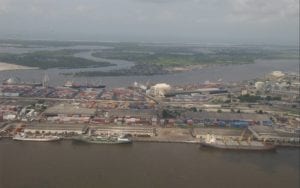In the whole of the ports in West and Central Africa, it is claimed that those in Nigeria attract the highest cost.
In fact, players in the industry, especially licenced clearing agents and importers are always in a hurry to point out that doing business at Nigerian ports is costliest in the world. Indeed, a keen observation of the country’s international trade dynamics, with regard to importation and cost of clearing goods, will reveal the authenticity of the claim. Costs emanating from long stay of cargo at the port, arising from cost of storage, demurrage and more are very commonly contested between service providers on one hand and agents and importers on the other hand. The development is no doubt leading to loss of revenue by the government, as about 40 per cent of imported goods consumed in the country come through the land borders, having been routed through neighbouring ports in Benin Republic, Togo, or Cameroun. A bulk of such goods is better smuggled into the country without proper payment of duties. With deep knowledge of these peculiarities, the Nigerian Customs Service is not leaving any stones unturned in strategising and re-strategising on the need for faster accomplishment of trade at the ports. The latest of these strategies is the new cargo exit procedure of the Apapa Command of the Nigerian Customs Service to ensure prompt clearance of cargoes from the Lagos Port Complex (LPC). The Customs Area Controller (CAC), Comptroller Mohammed Umar, at the Customs Stakeholders’ Forum held recently at the Command’s office in Apapa, said the enhanced cargo exit procedures was an outcome of the series of security meetings held by stakeholders at the LPC to remove the bottlenecks that hinder the smooth and quick exit of cargoes from the port. While noting that the new procedures would not tinker with the existing cargo clearance procedures, Comptroller Umar however, explained one of them to include that a container could only be released by Customs only after the clearing agent got the signatures of other relevant agencies on the Customs Sign-off Form.“We have come up with an idea that instead of agents or importers getting release from Customs before finishing other protocols, procedures, or even bringing in their truck to start loading, whereby the truck has to wait on the line, obstructing others to be exited, another way of doing it better is that after physical examination you should get all the signatories of the relevant agencies.
“It is only after you have done that that you can get release from Customs. Then the terminal operator will print exit note for you, which you take to the gate, and only when the gate office is satisfied that you are through with the procedures and formalities, that is when you can send back your documents for the triggering of your bill of lading to the terminal operator where you can load your container,” he said. Umar stressed that the procedure would help reduce congestion on the port’s exit road caused by container laden trucks left blocking the road by agents who proceed to complete other clearance procedures after getting release from Customs. The CAC further stated that it was also resolved that containers reported to be suspect while undergoing scanning would not be stacked in the same area as the unsuspected ones, but moved to a different stacking area for easy identification and positioning for physical examination. He explained that if a container was scanned and suspected, the driver of the truck carrying the container would immediately be given a red disk which would be presented to the APMT officials for such containers to be sorted out at a designated stacking area. The Customs chief noted that a Customs agent was expected to have applied to APMT for positioning of a container for physical examination before it would be done. Umar also explained that another outcome of the security meetings was that there would be a taskforce which would ensure that there would be no trucks packed on the port exit roads unnecessarily. While noting that the Command had the full support of APM Terminals, operator of Apapa Port and the port’s service provider, COTECNA in ensuring that the enhanced cargo exit procedures were implemented, the CAC urged agents to play by the rules of these procedures for a perfect operational system at the LPC







